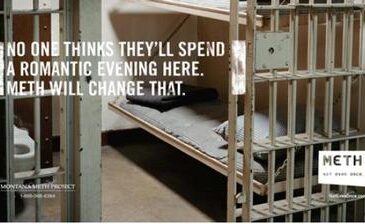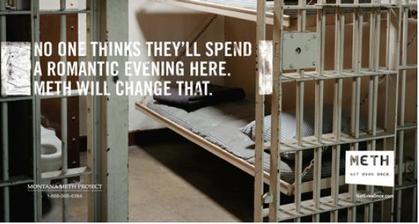Though some question the existence of a “meth epidemic” in the United States (see STASH 2(2)) others, like Thomas Siebel, aren’t taking any chances. Mr. Siebel, a software billionaire and part-time resident of Montana, is concerned about the increase in methamphetamine (meth) use in the state, especially among the state’s teenagers. According to the Montana Department of Justice, the number of people in treatment for methamphetamine abuse or dependence has increased by 70% during the past six years; currently, methamphetamine-related problems are usurping a disproportionate amount of resources allocated to law enforcement, social services, corrections and treatment (Office of the Attorney General). Mr. Siebel is determined to provide, and disseminate state-wide, vivid and scary images depicting the possible consequences of meth use. He intends these images to deter people from trying the drug ‘even once’ and preventing the development of meth use, abuse, and dependence. During February 2005, Mr. Siebel created the Montana Meth Project, an organization dedicated to increasing awareness of the consequences of meth use and abuse. Though the campaign is directed primarily at teens, Mr. Siebel hopes the campaign will reduce use among all population segments.
The Montana Meth Project’s unapologetic advertising campaign, launched on September 1, 2005, includes at least five different television commercials, four newspaper ads and billboard displays, and five radio spots. All of ads are accessible on their website. By promoting its anti-meth message through a multi-media campaign employing a variety of perspectives (e.g., true stories told by recovering meth users, photographs, fictional vignettes, etc.), the Montana Meth Project is trying to ensure that everyone in Montana is exposed to and affected by the message of this campaign in one way or another. The ads are designed to “unsell” methamphetamine use (Zernike, 2006): they are comprised of shocking images and scenarios that might result from meth abuse or dependence. Though many are critical of this approach, the campaign is getting the attention of teenagers as well as adults. It seems to be having an impact.
One of The Montana Meth Project’s Print Ads (from www.montanameth.org)
After the release of the ads, the Montana Meth Project, and the ads specifically, have received a deluge of media attention. In addition to the tens of articles that appeared in various Montana newspapers, the organization received attention from national news outlets such as CNN, The New York Times, NPR’s All Things Considered and Talk of the Nation, NBC Nightly News, and CBS Early Show, among others. The New York Times article quotes both parents and teens affected by the ads: though the teens interviewed had varying opinions on whether the ads were good or bad, they all seem to agree that the ads are getting their attention. They admit to having difficulty looking away. And though some parents might question the explicit nature of the ads, many acknowledge that the anti-meth ads offer a way to open a genuine dialogue between parents and their children about drug use. Some parents also think that the anti-drug message might be more effective coming from someone other than parents themselves (Zernike, 2006).
The fear tactics seem to be grabbing the attention of Montana youth, but it is unclear what the impact of this campaign will be in the long-run. Some speculate that this strategy could herald the future of anti-recreational-drug messages.
Efforts to prevent substance use and abuse are tricky, complex and often paradoxical. For example, what will happen if people do not end-up as the teens in these ads after trying meth ‘even once’? Will teens dismiss the campaign message as sensationalism, a shock and awe crusade without credibility? Drug prevention programs that attempted to scare youth into abstinence historically have yielded disappointing results (Donaldson et al., 1996); more worrisome, some drug abuse prevention programs had the opposite of the desired effect and resulted in higher rates of drug use (Rhule, 2005). The ads urge teens to try meth ‘not even once,’ but they do not allow for the fact that the choice is not always that simple: various social, psychological, biological or environmental issues might influence a person’s decision to try drugs (Donaldson et al., 1996).
The Montana Meth Project has very effectively corralled the attention of teens, parents and community members in an effort to prevent methamphetamine use—and that is an important accomplishment. However, a significant portion of this battle is still to come: now the challenge will be to ensure that the campaign yields the intended results.
What do you think? Comments can be addressed to Siri Odegaard.
References
Donaldson, S. I., Sussman, S., MacKinnon, D. P., Severson, H. H., Glynn, T., Murray, D. M., et al. (1996). Drug Abuse Prevention Programming: Do We Know What Content Works? American Behavioral Scientist, 39(7), 868-883.
Office of the Attorney General. Meth in Montana. Retrieved April 13, 2006, from http://www.doj.state.mt.us/ enforcement/methinmontana.asp
Rhule, D. M. (2005). Take Care to Do No Harm: Harmful Interventions for Youth Problem Behavior. Professional Psychology: Research and Practice, 36(6), 618-625.
Zernike, K. (2006, February 26). With Scenes of Blood and Pain, Ads Battle Methamphetamine in Montana. The New York Times, p. 18.





